Floors, often overlooked in the grand scheme of indoor hygiene, are surprisingly significant contributors to overall health and well-being. While the primary focus of cleaning has traditionally been on aesthetics, the growing awareness of the link between indoor air quality and human health has shifted the spotlight to the often-neglected surfaces beneath our feet.
Mold: A Silent Threat
Carpets, with their ability to trap moisture, create an ideal breeding ground for mold. This often-invisible enemy thrives in the warm, damp conditions beneath carpet fibers. Mold spores released into the air can trigger a range of health issues, from allergies and asthma to more severe respiratory problems.
The potential for mold growth is particularly high in areas prone to moisture, such as basements, bathrooms, and kitchens. Persistent dampness, even from minor leaks or spills, can create a breeding ground for mold that can be challenging to eradicate.
The Role of Foot Traffic
A significant factor in the spread of contaminants is foot traffic. Shoes carry bacteria, viruses, and other microorganisms from outside environments into buildings, where they are then transferred to floors.
The Impact on Indoor Air Quality
The relationship between floors and indoor air quality is complex and bidirectional. Floors serve as both sources and sinks for airborne contaminants. On one hand, contaminants on floor surfaces, such as bacteria, viruses, dust mites, pollen, and pet dander, can become airborne through various activities. Walking, vacuuming, and even simple air currents can agitate these particles, propelling them into the air where they can be inhaled.
Airborne particles from both indoor and outdoor sources eventually settle on floor surfaces. These particles can include dust, pollen, mold spores, and combustion byproducts. Once deposited, they accumulate on floors, carpets, and other surfaces, potentially contributing to indoor air pollution. This accumulation can lead to respiratory issues, allergies, and other health problems for building occupants.
The Health Implications
Respiratory problems: Allergic reactions, asthma, and other respiratory illnesses can be triggered by allergens and pollutants trapped in carpets and other flooring materials.

Infectious diseases: Bacteria and viruses can survive on floor surfaces, contributing to the spread of infectious diseases.
Skin infections: Direct contact with contaminated floors can lead to skin infections and irritations.
Protecting Your Health
To minimize the health risks associated with floor contaminants, consider the following steps: Regular and thorough cleaning Implement effective cleaning protocols, including vacuuming, mopping, and disinfecting, to remove dirt, germs, and allergens. Choose the appropriate flooring. Select flooring materials that are simple to clean and maintain, such as hardwood, tile, or vinyl. Proper ventilation, Ensure adequate ventilation to improve indoor air quality and reduce the accumulation of contaminants. Footwear removal, Encourage people to remove their shoes at the entrance to help prevent the spread of contaminants. Professional cleaning, Consider professional carpet cleaning or deep cleaning services for thorough removal of contaminants.
With Eco Flooring USA, you can transform your home!
Finally, it’s clear how removing your carpet can improve the aesthetic appeal, safety, and overall value of your home.
Eco Flooring USA offers comprehensive carpet removing services designed to meet your unique needs and style preferences. Our dedication lies in transforming your home into a beautiful and functional focal point.
Contact us today to schedule your free consultation and take the first step towards an exceptional staircase remodel!




